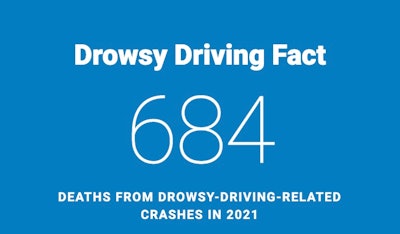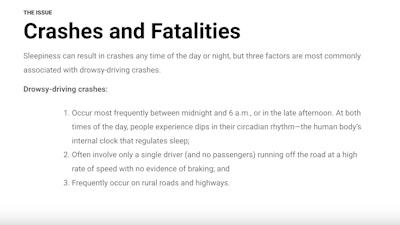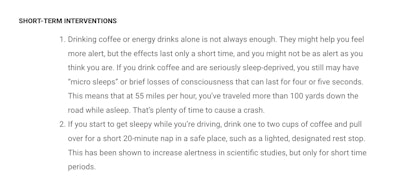
With summer already being the most dangerous time for driving, experts advise not only being extra cautious on the road but also to prepare ahead of time in a daily ritual that’s frequently overlooked: quality sleep.
Though winter months bring dangerous icy, snow-covered roads, state and federal agencies have long pointed out that more crashes occur during the summer. The National Highway Traffic Safety Administration reported a nearly 30% jump on average in fatal collisions during the summer months versus winter.
Labor Day to Memorial Day, that hectic time when trucks share the road with more motorists than any other season, has been repeatedly dubbed as the 100 deadliest days of summer.
While various factors lead to additional accidents, drowsy driving has increasingly caught the attention of safety experts, who now regularly include it as one of the four D’s of dangerous driving alongside drinking and driving, drugged driving and distracted driving.
[Related: Blue lights and late shifts invite drowsy driving]
 NHTSA
NHTSA
While some studies have shown that younger drivers are more at risk for drowsy driving, the Insurance Institute for Highway Safety (IIHS) said nailing down such statistics relative to fatigued driving is not easy.
“It’s very difficult to measure prevalence of driver fatigue through crash databases or the government’s FARS database, so we don’t have good information on the scope of the issue or whether certain demographics are at greater risk,” IIHS spokesman Joe Young said. “But there are some risks that can be measured that we know are associated with crash risk. Long driving hours increase crash risk, according to numerous studies. IIHS research has found that truck drivers behind the wheel for more than eight hours are twice as likely to crash.
“Even shorter uninterrupted drives appear to increase crash risk,” Young continued, referring to research conducted by IIHS and the University of North Carolina Highway Safety Research Center. “The estimate was not statistically significant, but the study found that driving more than five hours since getting out of the driver seat doubled crash risk. Hours-of-service violations are also linked with a higher likelihood of falling asleep behind the wheel and a higher likelihood of having caused a crash.”
[Related: Technology helping to reduce driving risks]
Educating drivers, managers on the need for sleep
Schneider (CCJ Top 250, No. 9) has long been on the front lines of not only educating its drivers on the importance of getting a good night’s rest, but also was one of the first carriers to implement a sleep apnea screening and prevention program. NHTSA
NHTSA
When it comes to tackling sleep deprivation, DiSalvi, who also serves as an NSF board member, said educating drivers on the importance of getting good sleep remains their top priority.
“We start with education and awareness,” DiSalvi said. “While most adults realize that you need to have sleep to perform well the next day, they don't always understand the detail. They don't always understand the physiological need for sleep, and that's what we train our driver associates when they first start at Schneider and provide that type of awareness throughout the course of their tenure at Schneider. What is the importance of consecutive hours of REM sleep? The importance of being alert throughout the course of the next day or when you need what we would refer to as strategic napping. We cover that in our education.”
[Related: Cell phone ban answer to distracted driving?]
DiSalvi said that in addition to helping drivers recognize the symptoms of sleep deprivation and encouraging them to get rest, the company also focuses on quality of sleep like “how to sleep in your truck and make the environment comfortable and conducive to sleep.”
That educational approach on the importance of getting productive sleep also extends to management.
“We want to make sure that our driver leaders, our frontline leaders not only understand our tenants of fatigue management, but also that they’re looking for specific things that they can coach the drivers on, making sure that every dispatch allows time for proper rest for our drivers,” DiSalvi said.
 NHTSA
NHTSA
“Another important piece is coaching our drivers on the avoidance of what we would call shift start variation, where someone that might drive during the day and sleep at night but then drives at night and sleeps during the day and vice versa because of the nature of their loads or delays or traffic,” DiSalvi said. “We know that is something to be avoided because that's very difficult on your body in terms of getting restful sleep.”
According to the CDC, most adults need at least seven hours of sleep a day and should consult a doctor for sleep issues, including snoring or tiredness. Medicines that cause drowsiness should be avoided while driving.
In addition to rumble strips on highways and roads, increased technology in truck cabs such as lane-keep assist and driver-facing cameras that recognize the signs of a sleepy driver can help reduce drowsy driving, but ultimately responsibility rests with the driver, which can be a battle at times.
“The researchers will tell us that we tend to be the worst judge of our own fatigue, and so we need to be able to articulate signs and symptoms to help drive our associates to recognize, 'Yeah, I might be getting tired, and it's time to start thinking about a place to get some rest,'” DiSalvi said.













